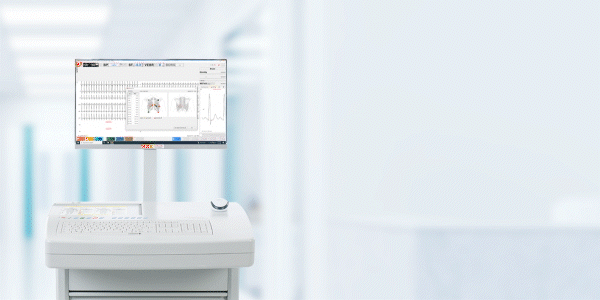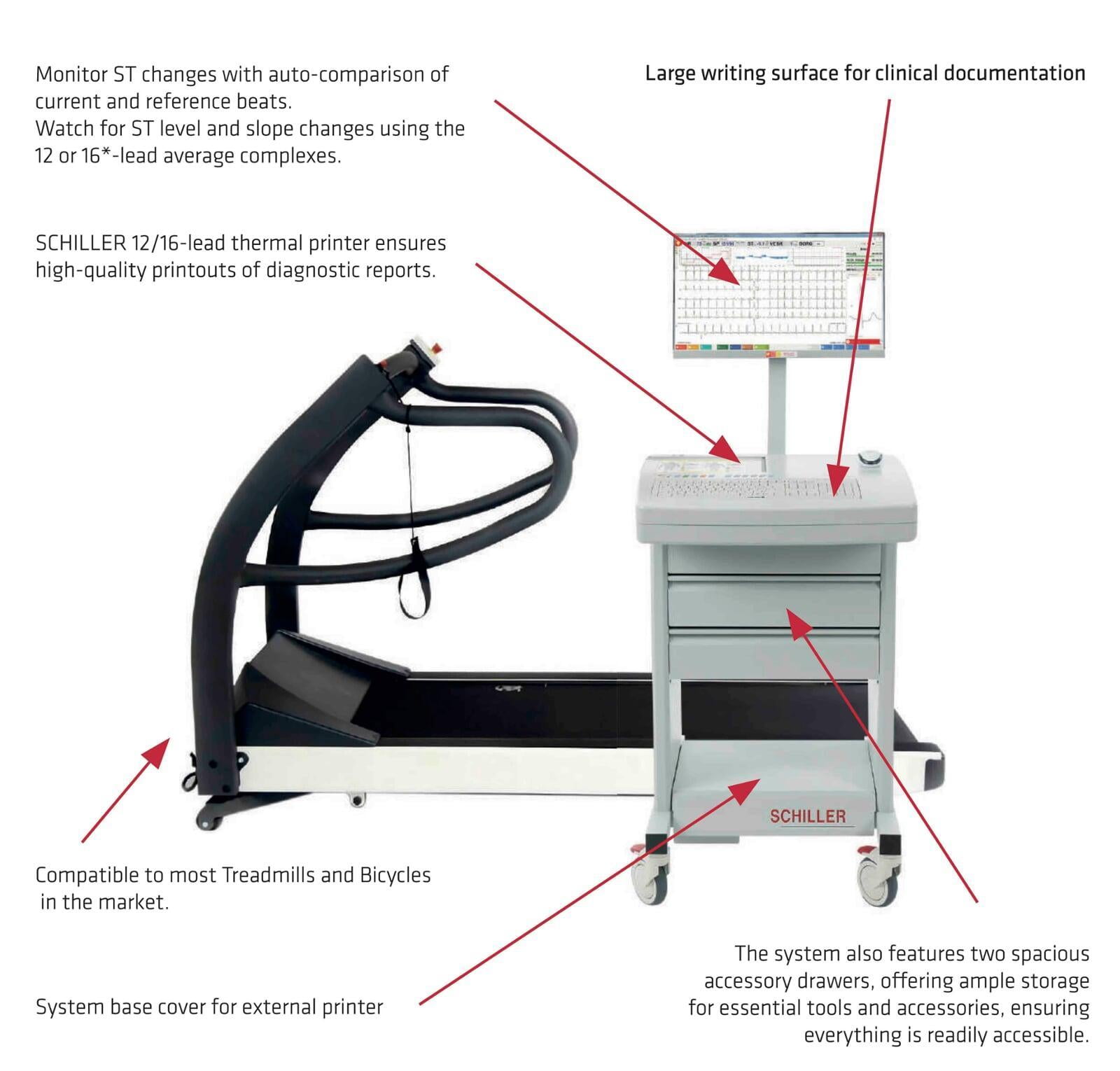By América Torres

Cardiologists have a wide range of non-invasive tests at their disposal to assess the hearts of patients with suspected heart diseases. These tests are useful tools for reaching a diagnosis, so the differences between them are significant.
In this blog, we will discuss the diagnostic and therapeutic utility of stress tests and what the CARDIOVIT CS-200 Excellence can contribute to provide the physician with a comprehensive overview to better care for their patients.
What is a stress test?
What is a stress test?
A stress test is a non-invasive procedure in which a patient's heart rate, blood pressure, and electrocardiogram are continuously monitored while the patient engages in physical exertion.
This procedure has proven to be highly effective in diagnosing coronary artery diseases; however, its use in diagnosing other cardiopulmonary conditions is limited. Measurements of the parameters must be taken:
Before the test, to obtain a diagnostic reference ECG.
At the end of each stage, to have a dynamic ECG of the patient's progress.
During the recovery phase. At least 15 minutes after the test has ended, or when signs and symptoms of cardiac or respiratory exhaustion have disappeared.
The stress test may be stopped for one or more of the following reasons:
- When the target heart rate (HR) has been reached.
- If the patient experiences extreme shortness of breath or fatigue.
- In the presence of chest pain or other exercise-induced symptoms.
- ST depression greater than 0.2 mV or elevation greater than 0.1 mV, as well as monophasic ST segment deviation.
- Increased QRS duration.
- Ventricular tachycardia.
- Ectopic supraventricular tachycardia.
- Exercise-induced intracardiac blocks.
- Peripheral circulatory failure (pallor, cold sweaty skin, low blood pressure).
- Patient's explicit desire to stop.
A positive result confirms the doctor's suspicions. A stress test is considered positive when the ECG shows horizontal or down sloping ST segment depression of 1 mm or more at 0.08 seconds after the J point that develops during or after exercise.
How does a stress test machine work?
How does a stress test machine work?
To get a better understanding of what a stress test does, it's important to comprehend what the normal response to exercise is.
During exercise, oxygen consumption increases proportionally with the workload imposed until reaching a maximum limit (VO2max). This increase occurs under certain conditions:
- Increased cardiac output due to an increase in heart rate and stroke volume.
- Increased alveolar ventilation.
- Increased oxygen diffusion capacity to the capillaries.
- Increased oxygen extraction by the muscles.
The objective of the stress test is to observe the patient's heart response to these factors, for which the patient is asked to use an exerciser. There are several types of exercisers, and the selection of such a device depends on three factors:
- The muscle groups that the patient will use during the test, and whether these groups are body support.
- The type of measurements that will be taken.
- The patient's physical capacity to undergo the test.
Therefore, the most commonly found exercisers in clinics that perform stress tests are ladders, cycle ergometers and treadmills. We are going to stop for a moment to analyze the advantages of these last two.
Stress test system with treadmill
Stress test system with treadmill
Treadmills are one of the most commonly used devices in the United States. The choice is based on the fact that walking is a simple activity accessible to everyone. When the test is conducted on a treadmill, the patient exerts effort on a system with variable incline (0-14%) and speed (1-10 MPH).
Stress test system with bicycle
Stress test system with bicycle
The bicycle, also known as a cycle ergometer, is the most versatile system for the test. It can be mechanical (where the patient maintains a constant pace against a constant resistance) or electromechanical (where the patient pedals against variable resistance). Additionally, they can be upright, supine, or hand cranked.
Now that we've discussed the purpose of the stress test and the exercisers most commonly used to perform it, let's move on to the core part: the equipment that will measure and analyze the test.
CARDIOVIT CS-200 Excellence Stress Test
CARDIOVIT CS-200 Excellence Stress Test
Having a stress test that offers all the necessary protocols for an adequate evaluation of the patient's cardiac function is a very useful tool. That's why SCHILLER designed the CARDIOVIT CS-200 Excellence, an ideal stress test for high patient volumes, which is not only precise but also intuitive to use, saving time and minimizing bureaucratic paperwork. Let's delve deeper into the capabilities of this powerful equipment.
CS-200 Excellence is a Stress Test System with Resting ECG and Rhythm features for a full cardiology assessment. It features algorithms that provide clear and reliable diagnoses during exercise. Its advanced software allows doctors to access and compare the results of various stress tests performed on patients.
That means the CARDIOVIT CS-200 Excellence Stress Test provides cardiology specialists with a wealth of valuable information to assist them in diagnosing and making evidence-based clinical decisions.
Unit components of CARDIOVIT CS-200 Excellence Stress Test
Unit components of CARDIOVIT CS-200 Excellence Stress Test
Before we explore all the capabilities of this innovative equipment, let's first examine its physical appearance.

As you may have noticed, the device is compact, featuring a large 24" TFT LCD monitor with a customizable display, according to user’s convenience or preferences. Additionally, it comes with a full keyboard, shortcut keys that activate the desired function with a single touch, and an integrated printer. The CS-200 is ideal for high patient volumes, so all these advantages have been designed to allow you to accomplish more in less time.
Features of this stress test machine
Features of this stress test machine
Now, let's take a look at some of the features that make the CS-200a must-have in the cardiology department of a clinic or hospital.
Connection visualization. The screen displays a color-coded electrode placement diagram and allows real-time visualization of the ECG waveform from all leads, to identify connection issues before starting the test. This prevents the need for repetition, saving time for the doctor, the clinic, and the patient.
Acquisition and analysis of 16-lead ECG. SCHILLER's 16-lead algorithm allows us to go beyond traditional interpretations of 12-lead resting ECGs. The combination of right precordial leads and the standard six left precordial leads significantly improves the sensitivity of exercise ECG for diagnosing coronary artery disease. Additionally, the integrated chest and back electrodes extend the interpretation of adult ECG.
Predefined exercise protocols. The stress test includes the most common exercise protocols for both treadmills and bicycle ergometers. For example, the Bruce and Modified Bruce (a.k.a Sheffield modification). In fact, the CS-200 Excellence not only has an adequate selection of pharmacological protocols but also has the capability to design a personalized exercise program tailored to the needs of each patient.
Stand-alone emergency ECG. In an emergency, every second counts. CARDIOVIT CS-200 Excellence allows you to print an emergency ECG, even before starting the system.
To sum it up, the CARDIOVIT CS-200 Excellence stress test is a sophisticated, modern, and dependable device, perfect for advancing cardiac patient care. See it in action! Click here to request a demonstration.


